Analysis of Stress Relaxation in Bulk and Porous Ultra-High Molecular Weight Polyethylene (UHMWPE)
Abstract
1. Introduction
2. Materials and Methods
2.1. Sample Preparation
2.2. X-ray Tomography
2.3. In-SEM Compression Testing
2.4. Porosity Evaluation
2.5. Digital Image Correlation
2.6. Stress Relaxation
- is the accumulated strain up to the initial instant ,
- are the values of Young’s moduli,
- are viscosities,
- and are relaxation times.
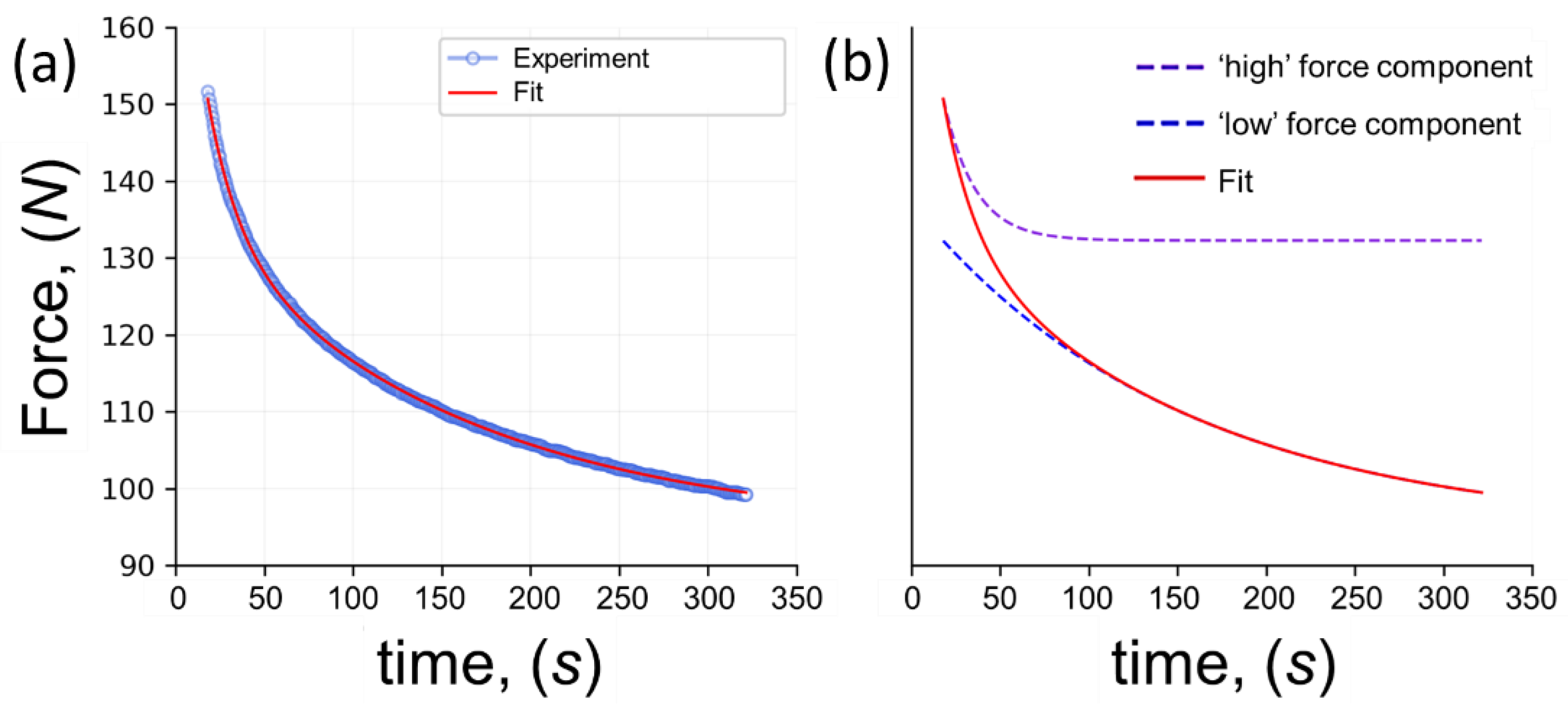
2.7. In Situ Tensile Loading and X-ray Scattering Study
3. Results and Discussion
3.1. X-ray Tomography
3.2. DIC Analysis
3.3. Stress Relaxation Analysis
3.4. In Situ SAXS Tests
3.5. Stiffness Evolution Analysis
- is Young’s modulus of the solid material,
- is the fraction of solid contained in the cell edges—
- (1)
- The material with relative density equal to zero has null elastic modulus.
- (2)
- The solid UHMWPE has Young’s modulus of 1100 MPa that was determined from the experiment.

4. Conclusions
- (1)
- Stress relaxation of solid (R = 1) and porous (R = 0.60/0.65/0.70/0.75) UHMWPE was studied.
- (2)
- Statistically significant conclusions could be drawn from the comparison between experiment and theory. The obtained relaxation curves were fitted with simple two-term Prony series where two relaxation times were extracted. It was postulated that the observed times are connected with molecular (physical cross-links and entanglements) and structural (recovery of cell walls, trusses and nodes in porous structure) relaxation mechanisms, respectively. The two times were found to be approximately equal to 20 s and 160 s.
- (3)
- Porous structures, i.e., geometrical characteristics of the pore space, were investigated by X-ray tomography. The results showed a mixture of open and close pores within cells with massive solid walls.
- (4)
- The relaxation times are almost independent of the porosity and the apparent compression strain.
- (5)
- The apparent stiffness of the porous polymer was matched with a three-term expression derived on the basis of the Gibson and Ashby model.
- (6)
- Further investigations are needed to study the temperature dependence of the relaxation parameters.
Supplementary Materials
Author Contributions
Funding
Institutional Review Board Statement
Informed Consent Statement
Data Availability Statement
Acknowledgments
Conflicts of Interest
References
- Hussain, M.; Naqvi, R.A.; Abbas, N.; Khan, S.M.; Nawaz, S.; Hussain, A.; Zahra, N.; Khalid, M.W. Ultra-High-Molecular-Weight-Polyethylene (UHMWPE) as a Promising Polymer Material for Biomedical Applications: A Concise Review. Polymers 2020, 12, 323. [Google Scholar] [CrossRef] [PubMed]
- Gladius, L. Properties of Crosslinked Ultra-High-Molecular-Weight Polyethylene. Biomaterials 2001, 22, 371–401. [Google Scholar] [CrossRef]
- Kong, D.-C.; Yang, M.-H.; Zhang, X.-S.; Du, Z.-C.; Fu, Q.; Gao, X.-Q.; Gong, J.-W. Control of Polymer Properties by Entanglement: A Review. Macromol. Mater. Eng. 2021, 306, 2100536. [Google Scholar] [CrossRef]
- Pakhomov, P.; Khizhnyak, S.; Rogova, K.; Jehnichen, D.; Hofmann, T.; Hartmann, D.; Galitsyn, V.; Tshmel, A. Crystalline Phase in Gelled UHMWPE Reactor Powder. Int. J. Polym. Anal. Charact. 2011, 16, 60–66. [Google Scholar] [CrossRef]
- Sobieraj, M.C.; Rimnac, C.M. Ultra High Molecular Weight Polyethylene: Mechanics, Morphology, and Clinical Behavior. J. Mech. Behav. Biomed. Mater. 2009, 2, 433–443. [Google Scholar] [CrossRef] [PubMed]
- Deng, M.; Shalaby, S.W. Properties of Self-reinforced Ultra-high-molecular-weight Polyethylene Composites. Biomaterials 1997, 18, 645–655. [Google Scholar] [CrossRef]
- Zherebtsov, D.; Chukov, D.; Royaud, I.; Ponçot, M.; Larin, I.; Statnik, E.S.; Drozdova, T.; Kirichenko, A.; Salimon, A.; Sherif, G.; et al. On the Structural Peculiarities of Self-Reinforced Composite Materials Based on UHMWPE Fibers. Polymers 2021, 13, 1408. [Google Scholar] [CrossRef]
- Rutledge, G.C.; Park, J.H. Gel-electrospinning Process for Preparing High Performance Polymer Nanofibers. Patent WO2017123293A2, 24 August 2017. [Google Scholar]
- Rein, D.M.; Shavit-Hadar, L.; Khalfin, R.L.; Cohen, Y.; Shuster, K.; Zussman, E. Electrospinning of Ultra-high-molecular-weight Polyethylene Nanofibers. J. Polym. Sci. Part B 2007, 45, 766–773. [Google Scholar] [CrossRef]
- Li, J.; Li, R.; Gu, Q.; Zhang, Q.; Yu, T.X.; Gao, P. Flexible Ultrastrong 100-nm Polyethylene Membranes with Polygonal Pore Structures. arXiv 2019, arXiv:1901.07952. [Google Scholar]
- Pluyter, P.B.; Lambert, P.S.; Unen, L.H.T.; Rutten, H.J.J. Process of Making Microporous Films of UHMWPE. Patent US5248461A, 28 September 2010. [Google Scholar]
- Maksimkin, A.V.; Senatov, F.S.; Anisimova, N.Y.; Kiselevskiy, M.V.; Zalepugin, D.Y.; Chernyshov, I.V.; Tilkunova, N.A.; Kaloshkin, S.D. Multilayer Porous UHMWPE Scaffolds for Bone Defects Replacement. Mater. Sci. Eng. C 2017, 73, 366–372. [Google Scholar] [CrossRef]
- Lermontov, S.A.; Malkova, A.N.; Supyagina, N.A.; Straumal, E.A.; Maksimkin, A.V.; Kolesnikov, E.A.; Senatov, F.S. Properties of Highly Porous Aerogels Prepared from Ultra-high Molecular Weight Polyethylene. Polymer 2019, 182, 121824. [Google Scholar] [CrossRef]
- Pegoretti, A.; Ashkar, M.; Migliaresi, C.; Marom, G. Relaxation Processes in Polyethylene Fibre-reinforced Polyethylene Composites. Compos. Sci. Technol. 2000, 60, 1181–1189. [Google Scholar] [CrossRef]
- Salimon, A.I.; Statnik, E.S.; Zadorozhnyy, M.Y.; Senatov, F.S.; Zherebtsov, D.D.; Safonov, A.A.; Korsunsky, A.M. Porous Open-Cell UHMWPE: Experimental Study of Structure and Mechanical Properties. Materials 2019, 12, 2195. [Google Scholar] [CrossRef] [PubMed]
- Statnik, E.S.; Dragu, C.; Besnard, C.; Lunt, A.J.G.; Salimon, A.I.; Maksimkin, A.; Korsunsky, A.M. Multi-Scale Digital Image Correlation Analysis of In situ Deformation of Open-Cell Porous Ultra-High Molecular Weight Polyethylene Foam. Polymers 2020, 12, 2607. [Google Scholar] [CrossRef] [PubMed]
- Kan, Y.; Cvjetinovic, J.; Statnik, E.S.; Ryazantsev, E.S.; Anisimova, N.Y.; Kiselevskiy, M.V.; Salimon, A.I.; Maksimkin, A.V.; Korsunsky, A.M. The Fabrication and Characterization of Bioengineered Ultra-high Molecular Weight Polyethylene-collagen-hap Hybrid Bone-cartilage Patch. Mater. Today Commun. 2020, 24, 101052. [Google Scholar] [CrossRef]
- Gabriel, M.C.; Mendes, L.B.; Carvalho, B.M.; Pinheiro, L.A.; Capochi, J.D.P.; Kubaski, E.T.; Cintho, O.M. High-Energy Mechanical Milling of Ultra-High Molecular Weight Polyethylene (UHMWPE). Mater. Sci. Forum 2010, 660–661, 325–328. [Google Scholar] [CrossRef]
- Senatov, F.S.; Niaza, K.V.; Salimon, A.I.; Maksimkin, A.V.; Kaloshkin, S.D. Architected UHMWPE Simulating Trabecular Bone Tissue. Mater. Today Commun. 2018, 14, 124–127. [Google Scholar] [CrossRef]
- Lermontov, S.A.; Maksimkin, A.V.; Sipyagina, N.A.; Malkova, A.N.; Kolesnikov, E.A.; Zadorozhnyy, M.Y.; Straumal, E.A.; Dayyoub, T. Ultra-high Molecular Weight Polyethylene with Hybrid Porous Structure. Polymer 2020, 202, 122744. [Google Scholar] [CrossRef]
- Dewanckele, J.; Boone, M.A.; Coppens, F.; Van Loo, D.; Merkle, A.P. Innovations in Laboratory-based Dynamic Micro-CT to Accelerate in situ Research. J. Microsc. 2020, 277, 197–209. [Google Scholar] [CrossRef]
- Dragonfly 2020.2 [Computer Software]; Object Research Systems (ORS) Inc.: Montreal, QC, Canada, 2020; Available online: http://www.theobjects.com/dragonfly (accessed on 7 October 2022).
- Schindelin, J.; Arganda-Carreras, I.; Frise, E.; Kaynig, V.; Longair, M.; Pietzsch, T.; Preibisch, S.; Rueden, C.; Saalfeld, S.; Schmid, B.; et al. Fiji: An open-source platform for biological-image analysis. Nat. Methods 2012, 9, 676–682. [Google Scholar] [CrossRef]
- Blaber, J.; Adair, B.; Antoniou, A. Ncorr: Open-Source 2D Digital Image Correlation Matlab Software. Exp. Mech. 2015, 55, 1105–1122. [Google Scholar] [CrossRef]
- Pacheco, J.E.L.; Bavastri, C.A.; Pereira, J.T. Viscoelastic Relaxation Modulus Characterization Using Prony Series. Lat. Am. J. Solids Struct. 2015, 12, 420–445. [Google Scholar] [CrossRef]
- Delin, M.; Rychwalski, R.W.; Kubát, M.J.; Kubát, J. Volume changes during stress relaxation in polyethylene. Rheol. Acta 1995, 34, 182–195. [Google Scholar] [CrossRef]
- McCready, E.M.; Burghardt, W.R. In situ SAXS Studies of Structural Relaxation of an Ordered Block Copolymer Melt Following Cessation of Uniaxial Extensional Flow. Macromolecules 2015, 48, 264–271. [Google Scholar] [CrossRef]
- Petrov, A.; Rudyak, V.Y.; Kos, P.; Chertovich, A. Polymerization of Low-Entangled Ultrahigh Molecular Weight Polyethylene: Analytical Model and Computer Simulations. Macromolecules 2020, 53, 6796–6808. [Google Scholar] [CrossRef]
- McDaniel, P.; Deitzel, J.M.; Gillespie, J.W., Jr. Structural Hierarchy of Ultra High Molecular Weight Polyethylene (UHMWPE) Fibers Studied by Atomic Force Microscopy. Available online: https://www.ccm.udel.edu/research_summaries/structural-hierarchy-of-ultra-high-molecular-weight-polyethylene-uhmwpe-fibers-studied-by-atomic-force-microscopy/ (accessed on 7 October 2022).
- An, M.; Lv, Y.; Xu, H.; Li, Y.; Wang, Z. Formation and evolution of shish-kebab structure during hot stretching in gel-spun ultra-high molecular weight polyethylene fibers with high concentration gel solution. Polym. Cryst. 2019, 2, e10060. [Google Scholar] [CrossRef]
- Obdrup, A.S.; Wieland, D.F.; Huss-Hansen, M.K.; Arras, M.M.; Knaapila, M. Classifying condition of ultra-high-molecular-weight polyethylene ropes with wide-angle X-ray scattering. Polym. Test. 2022, 109, 107524. [Google Scholar] [CrossRef]
- Sui, T.; Baimpas, N.; Dolbnya, I.P.; Prisacariu, C.; Korsunsky, A.M. Multiple-length-scale deformation analysis in a thermoplastic polyurethane. Nat. Commun. 2015, 6, 6583. [Google Scholar] [CrossRef]
- Sui, T.; Salvati, E.; Ying, S.; Sun, G.; Dolbnya, I.P.; Dragnevski, K.; Prisacariu, C.; Korsunsky, A.M. Strain softening of nano-scale fuzzy interfaces causes Mullins effect in thermoplastic polyurethane. Sci. Rep. 2017, 7, 916. [Google Scholar] [CrossRef]
- Gazzano, M.; Gualandi, C.; Zucchelli, A.; Sui, T.; Korsunsky, A.M.; Reinhard, C.; Focarete, M.L. Structure-morphology correlation in electrospun fibers of semicrystalline polymers by simultaneous synchrotron SAXS-WAXD. Polymer 2015, 63, 154–163. [Google Scholar] [CrossRef]
- Ko, W.L. Deformations of Foamed Elastomers. J. Cell. Plast. 1965, 1, 45–50. [Google Scholar] [CrossRef]
- Gibson, L.; Ashby, M. Cellular Solids: Structure and Properties; Cambridge University Press: Cambridge, UK, 1997. [Google Scholar] [CrossRef]
- Avalle, M.; Scattina, A. Mechanical properties and impact behavior of a microcellular structural foam. Lat. Am. J. Solids Struct. 2014, 11, 200–222. [Google Scholar] [CrossRef]
- Bezazi, A.; Frioui, N.; Scarpa, F. Tensile Static, Fatigue and Relaxation Behaviour of Closed Cell Electret PVDF Foams. Mech. Mater. 2011, 43, 459–466. [Google Scholar] [CrossRef]

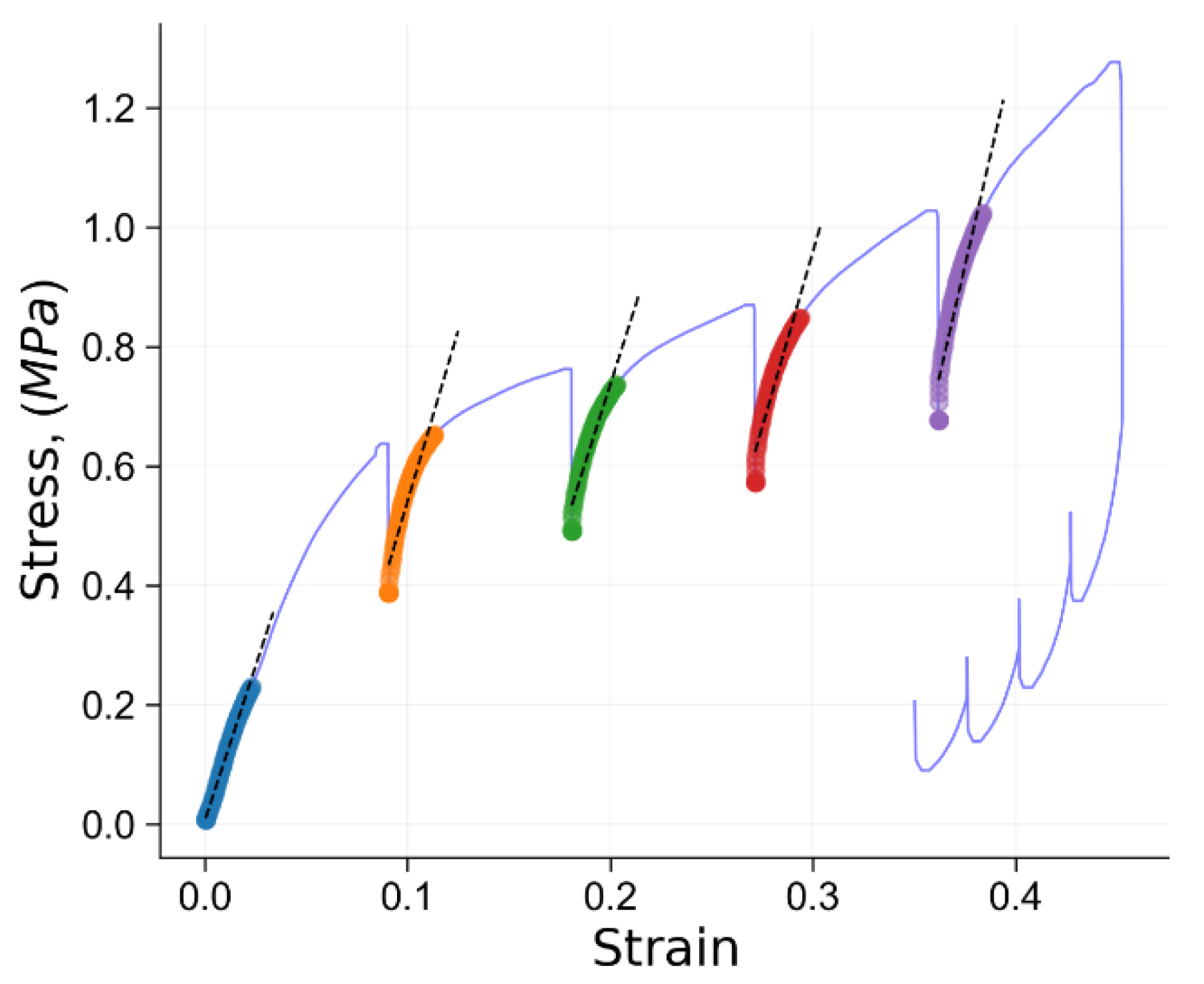

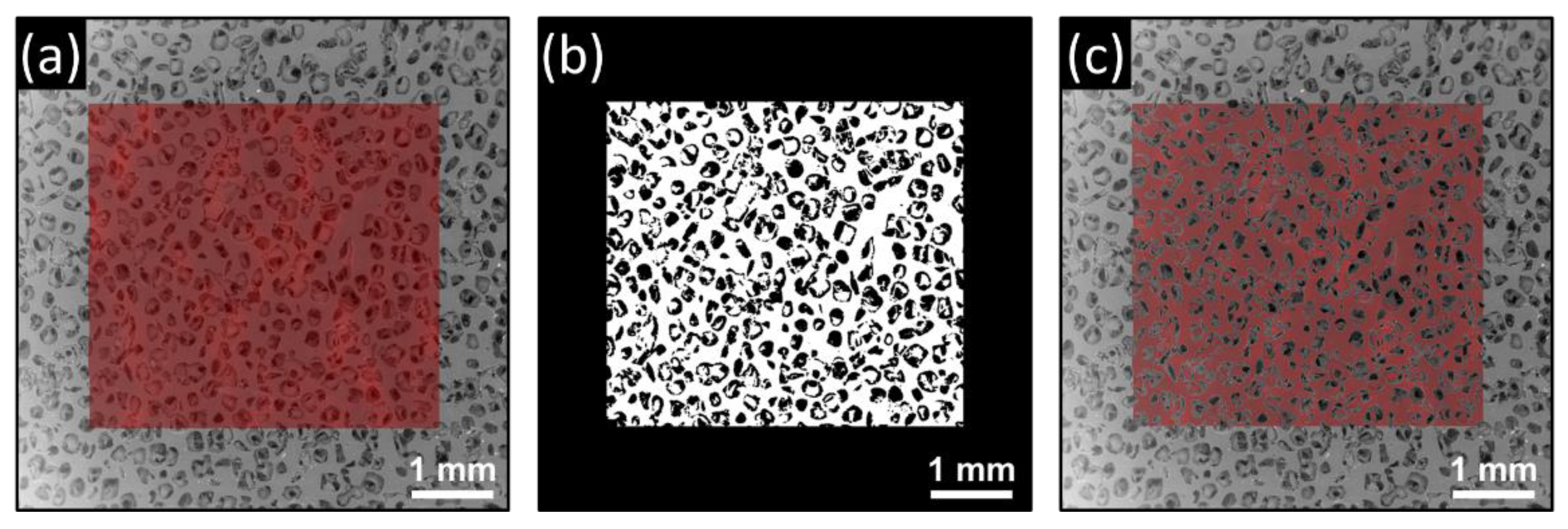
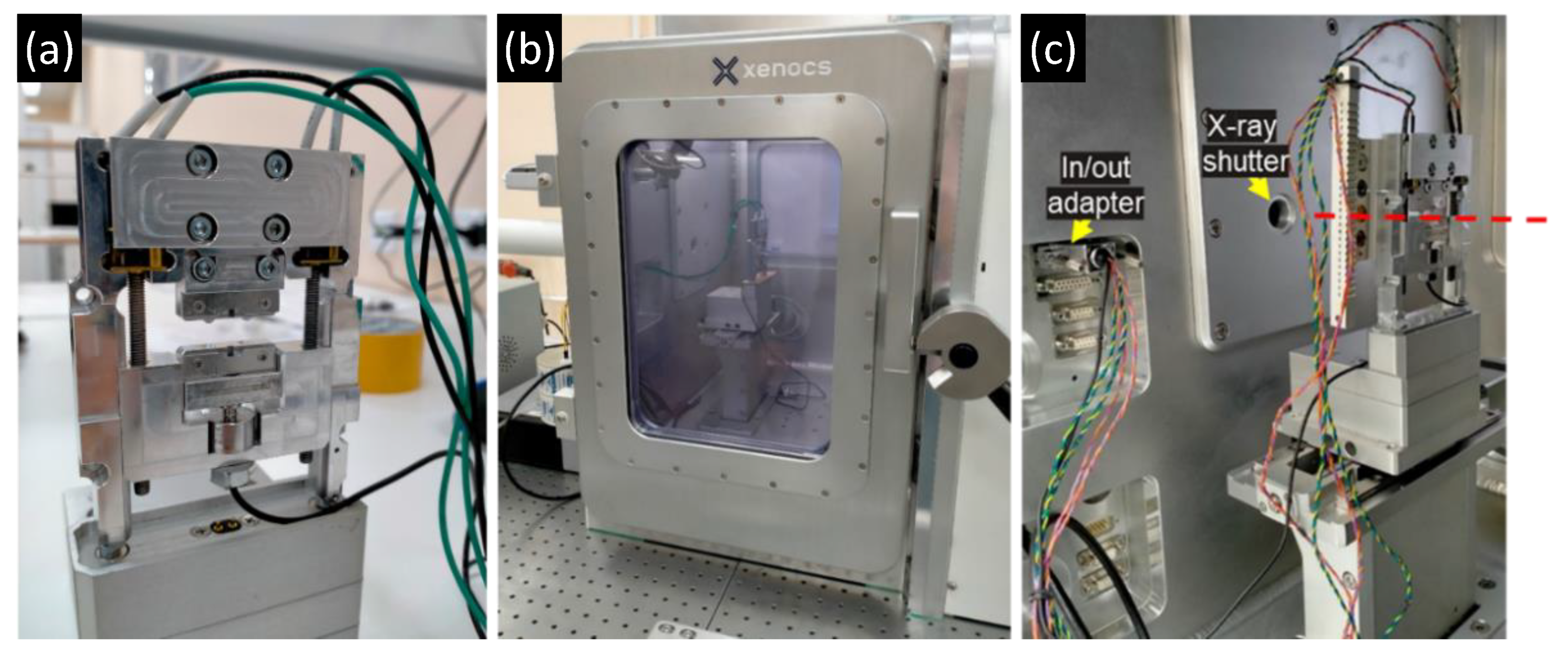
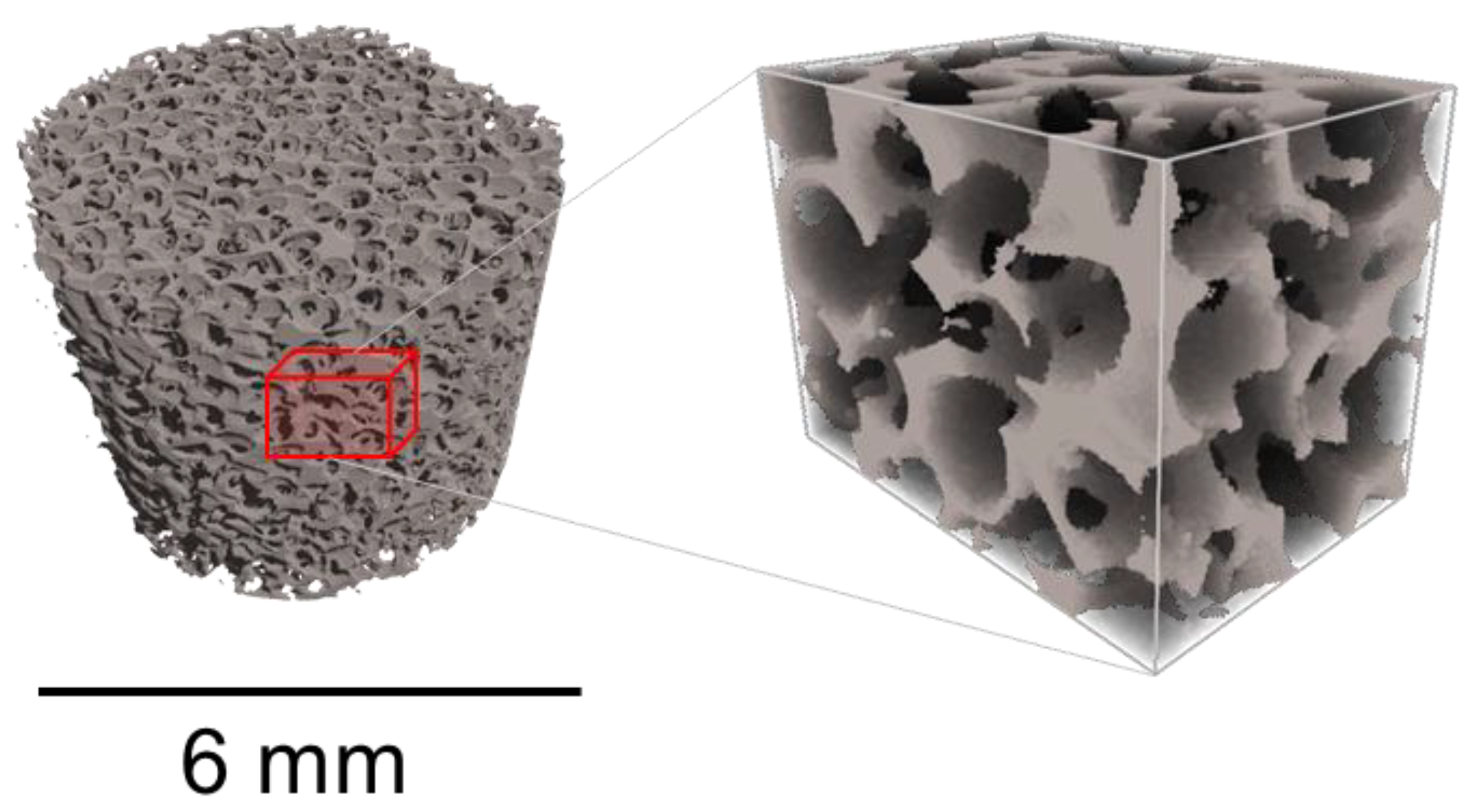


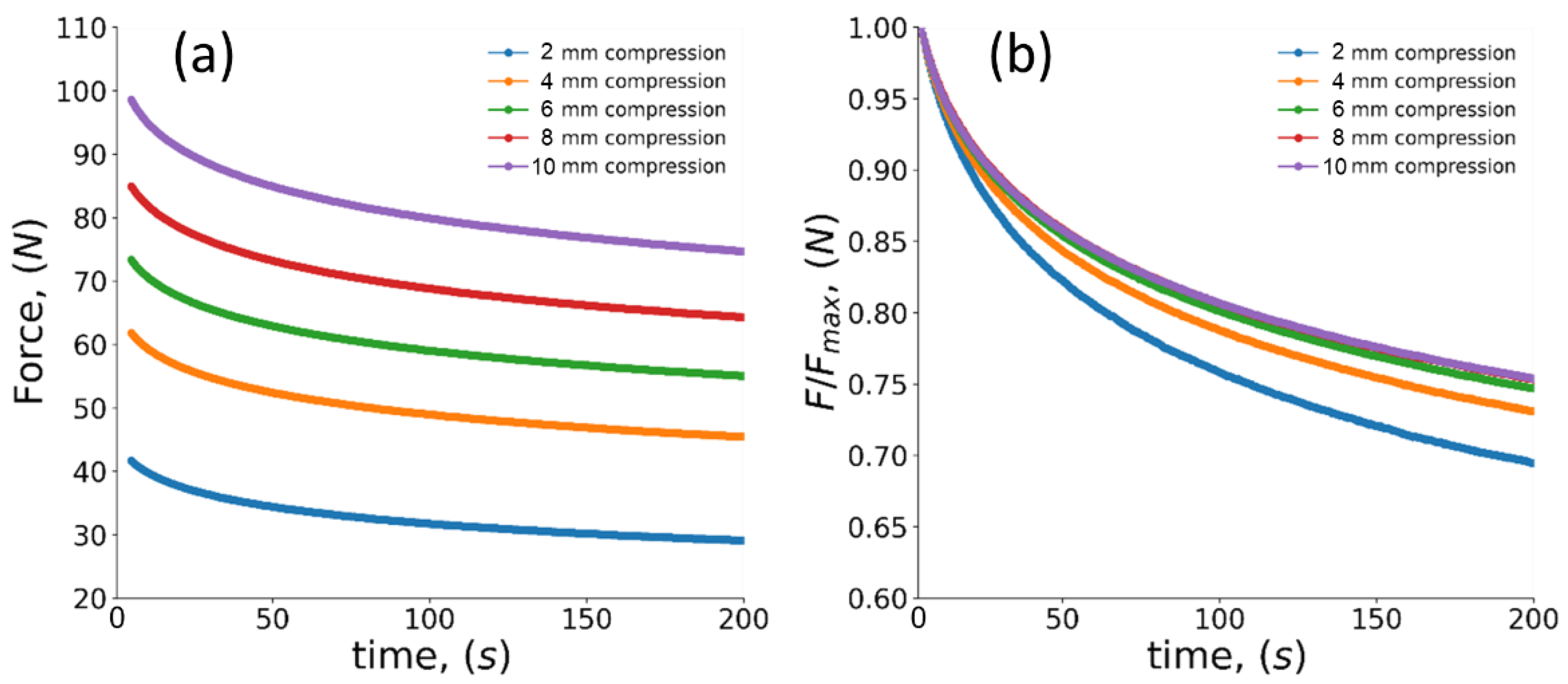
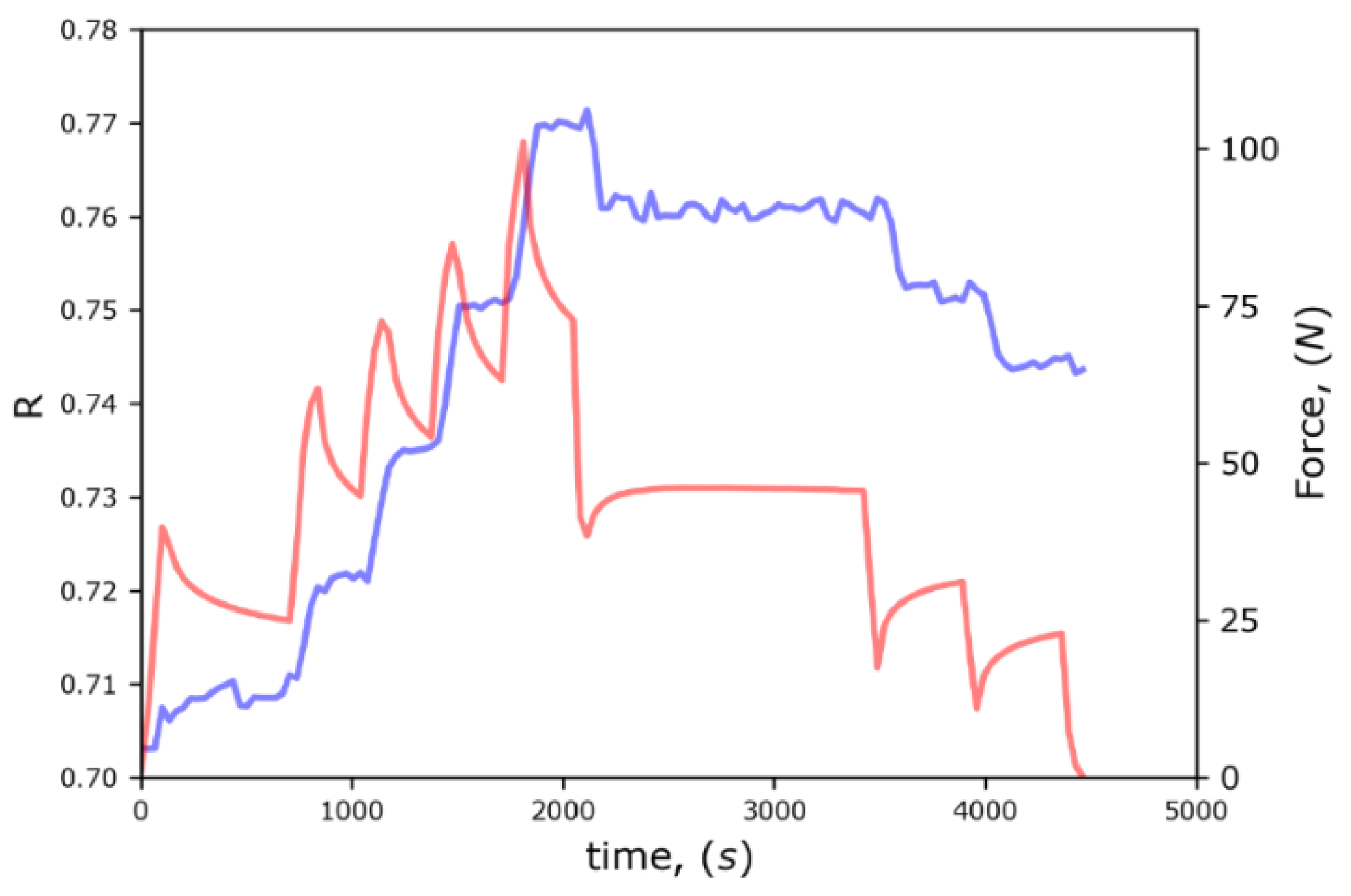
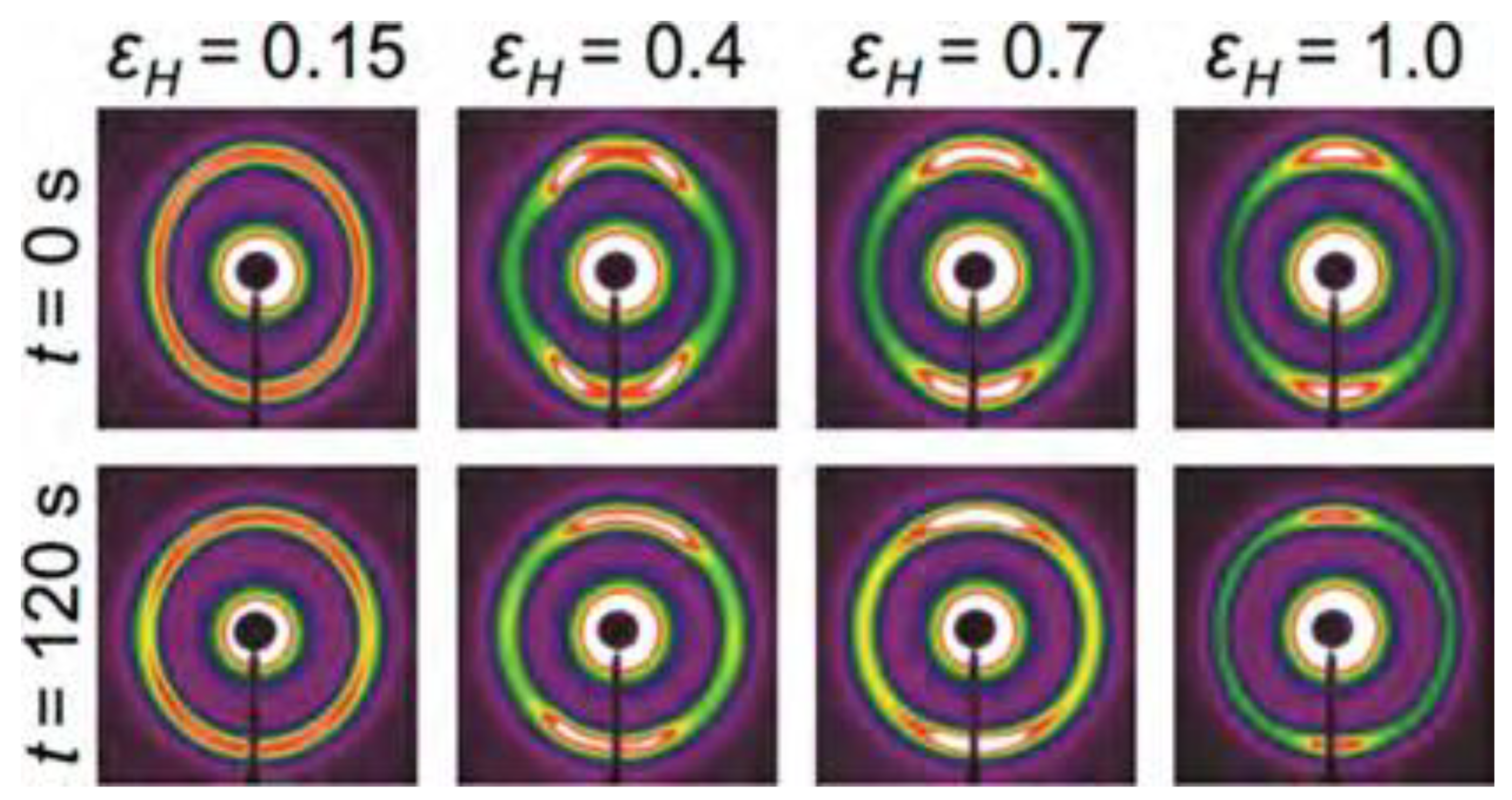


| Time, s | ||
|---|---|---|
| 0 | - | - |
| 75 | 0.06 | 0.06 |
| 150 | 0.04 | 0.10 |
| 225 | 0.07 | 0.17 |
| 300 | 0.55 | 0.72 |
| Porosity, % | |||||
|---|---|---|---|---|---|
| 0 | 25 | 30 | 40 | ||
| Compression stage | 2 mm | 178 ± 8 | 145 ± 13 | 145 ± 8 | 149 ± 6 |
| 4 mm | 187 ± 7 | 142 ± 10 | 152 ± 8 | 162 ± 6 | |
| 6 mm | 183 ± 6 | 148 ± 11 | 153 ± 7 | 159 ± 6 | |
| 8 mm | 189 ± 6 | 148 ± 10 | 152 ± 7 | 162 ± 5 | |
| ‘High’ force component () | Porosity, % | ||||
| 0 | 25 | 30 | 40 | ||
| Compression stage | 2 mm | 23 ± 1 | 25 ± 2 | 17 ± 1 | 18 ± 1 |
| 4 mm | 24 ± 1 | 16 ± 2 | 17 ± 1 | 20 ± 1 | |
| 6 mm | 22 ± 1 | 18 ± 2 | 18 ± 1 | 19 ± 1 | |
| 8 mm | 23 ± 1 | 17 ± 2 | 18 ± 1 | 19 ± 1 | |
Publisher’s Note: MDPI stays neutral with regard to jurisdictional claims in published maps and institutional affiliations. |
© 2022 by the authors. Licensee MDPI, Basel, Switzerland. This article is an open access article distributed under the terms and conditions of the Creative Commons Attribution (CC BY) license (https://creativecommons.org/licenses/by/4.0/).
Share and Cite
Statnik, E.S.; Salimon, A.I.; Gorshkova, Y.E.; Kaladzinskaya, N.S.; Markova, L.V.; Korsunsky, A.M. Analysis of Stress Relaxation in Bulk and Porous Ultra-High Molecular Weight Polyethylene (UHMWPE). Polymers 2022, 14, 5374. https://doi.org/10.3390/polym14245374
Statnik ES, Salimon AI, Gorshkova YE, Kaladzinskaya NS, Markova LV, Korsunsky AM. Analysis of Stress Relaxation in Bulk and Porous Ultra-High Molecular Weight Polyethylene (UHMWPE). Polymers. 2022; 14(24):5374. https://doi.org/10.3390/polym14245374
Chicago/Turabian StyleStatnik, Eugene S., Alexey I. Salimon, Yulia E. Gorshkova, Natallia S. Kaladzinskaya, Ludmila V. Markova, and Alexander M. Korsunsky. 2022. "Analysis of Stress Relaxation in Bulk and Porous Ultra-High Molecular Weight Polyethylene (UHMWPE)" Polymers 14, no. 24: 5374. https://doi.org/10.3390/polym14245374
APA StyleStatnik, E. S., Salimon, A. I., Gorshkova, Y. E., Kaladzinskaya, N. S., Markova, L. V., & Korsunsky, A. M. (2022). Analysis of Stress Relaxation in Bulk and Porous Ultra-High Molecular Weight Polyethylene (UHMWPE). Polymers, 14(24), 5374. https://doi.org/10.3390/polym14245374









